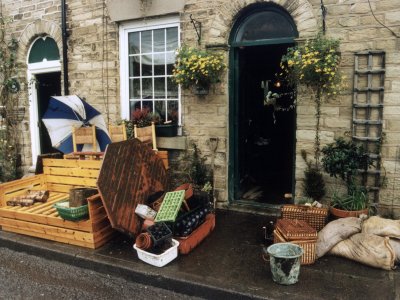

home > what to do > disinfection
 |
| Photo: Environment Agency |
During clean up the following safety precautions should be followed:
It is not recommended that you fully re-occupy your property until the following steps have been carried out:
Mud should be removed from your property. Mud will invariable be contaminated from a variety of sources, particularly sewage. Shovel out as much mud as possible and then use a garden sprayer or hose to wash away mud from hard surfaces. Remember to hose out ducts (having disconected them from any appliances such as central heating systems) and other void spaces. If large volumes of mud and silt have been left in and around your building remove mud from inside and outside of the walls to ensure that they do not have excessive loads on one side of the wall.
Clean by scrubbing surfaces with hot soapy water and a heavy duty cleaner, using a brush. When clean rinse the soap off surfaces. Make sure that you clean in hidden voids (for example, behind and under kitchen units and cupboards), as the floodwaters are likely to have entered these areas too. The flood water may have contained oil or diesel - if some still remains once the flood water and silt have been removed, clean by using a detergent solution. If in doubt about what has been contaminated, remember that it is better to be safe than sorry, especially in the case of objects like soft furnishings and clothes.
Any obviously spoiled goods should be placed in plastic rubbish sacks (tied securely) and disposed of. This includes any foodstuffs that have come into contact with the floodwaters. Remove all soft furnishings and fittings that are damaged beyond repair.
Domestic disinfectants should be used on all areas that have been in contact with floodwaters following cleaning. When using disinfectants follow the directions on the packaging to ensure that you disinfect the area effectively.
All food preparation surfaces, equipment, containers, utensils, crockery and cutlery must be thoroughly cleaned and disinfected before use.
Allow all cleansed and disinfected areas to thoroughly dry - the majority of germs and infective organisms require water to survive. See page on pumping and drying out for further details on drying out your property. Take furniture, rugs, bedding and clothing outside to dry as soon as possible - this will assist in the prevention of moulds.
Your local authority may be able to help with advice and clean up materials.
Moulds can pose a health hazard, especially for infants, the elderly and those with asthma, allergies, or illnesses. If mould is present, or materials have not been cleaned and dried within two or three days of the floodwater receding, then vulnerable persons should stay away during restoration and precautions should be taken to protect workers. Well-fitting respirators with toxic particle cartridges are recommended; dust masks are not adequate. Respirators are available at DIY or building centres.
Mildew is a growing organism that can permanently damage most textile fibres - especially natural fibres such as cotton, linen, rayon and wool. Mould exposure may cause cold-like symptoms, watery eyes, sore throat, wheezing and dizziness and trigger asthma attacks. Because some mould spores are very small and can easily be breathed deeply into the lungs, it is not safe to live in houses with high mould levels.
Moulds can usually be detected by a musty odour and discoloration of surfaces is common with mould growth. The mould may change surfaces to white, green, brown, black or orange.
Reliable sampling for mould can be expensive since it requires special equipment
and training, testing for mould is not generally recommended as a first step.
The solution to mildew problems is to disinfect and dry.
20 November 2002